Digi 提供各种无线模块,可帮助新产品在短时间内投入运行。Digi XBee® 射频产品按照最高质量标准制造,并随附开发人员快速将其集成到IoT 设备所需的所有工具和代码库。
Digi XBee 产品系列
Digi XBee 无线模块可分为两大类:短距离和长距离。
短距离 XBee 模块
我们的短程模块工作频率为 2.4 GHz,支持各种协议。其中之一是 802.15.4 协议,可实现快速、低延迟的点对点和点对多点通信。这对于远程控制应用以及所有设备都在彼此直接范围内时非常有用。我们还提供两种网状技术:Zigbee 和 DigiMesh。这两种技术都可用于创建智能、自路由和自修复的网状网络。Zigbee 是一种开放、可互操作的标准。DigiMesh 是 Digi 开发的一种协议,支持完全由电池供电的网状网络。
这些模块有多种硬件变体,可支持不同的使用情况。它们既兼容引脚,也兼容软件,便于从一种技术切换到另一种技术。这样,解决方案提供商就可以在新模块发布时轻松地将其转换为新模块。此外,这些模块还通过了全球认证。这些认证缩短了产品上市时间,因为制造商通常不必担心模块在其所在地区获得认证。
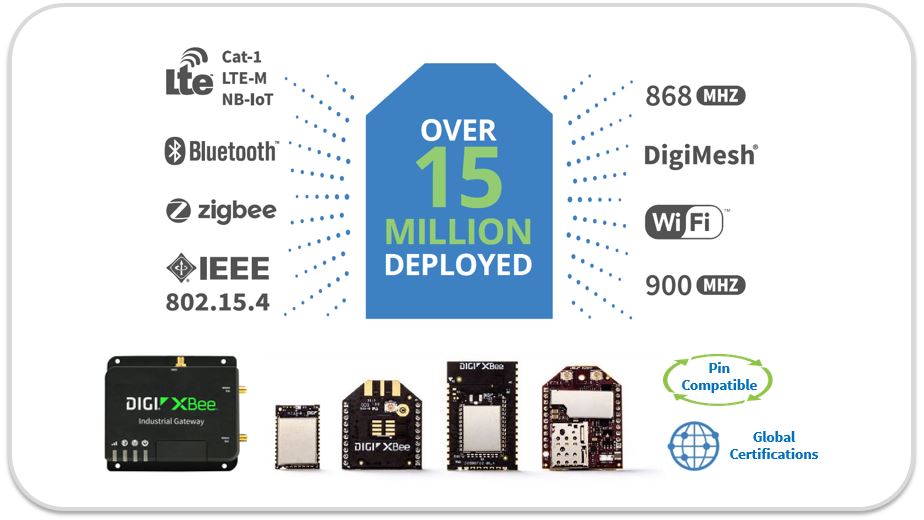
长距离 XBee 模块
长距离应用可以使用我们的 sub-GHz 模块(支持 868 MHz 和 900 MHz)或Digi XBee 蜂窝模块来实现。
与 2.4 GHz 相比,sub-GHz 模块在吞吐量较低的情况下提供了更大的范围和更强的材料穿透力,使其成为远距离应用或具有挑战性的室内环境的可行选择。
蜂窝 XBee 模块
最后但同样重要的是,Digi XBee 模块支持各种蜂窝标准,包括 3G、LTE Cat-1、LTE-M 和 NB-IoT 。
蜂窝 XBee 产品系列支持 Wi-Fi 接入具有挑战性的许多移动和工业应用。
不确定哪种连接方式适合您的应用?请联系 Digi。
外形因素
Digi 目前提供三种不同的硬件型号:
- 被称为 MMT 的微型模块
- 通孔模块,底部连接有引脚
- 更大的 SMT 模块,向后兼容传统 XBee 模块
Digi XBee 蜂窝模块是通孔外形尺寸的一种变体,带有额外的 UFL 连接器和 SIM 卡插槽。所有这些模块都提供各种天线选项,具体取决于实际使用的变体,如 PCB 或芯片天线、UFL、SMA 和射频垫连接器。
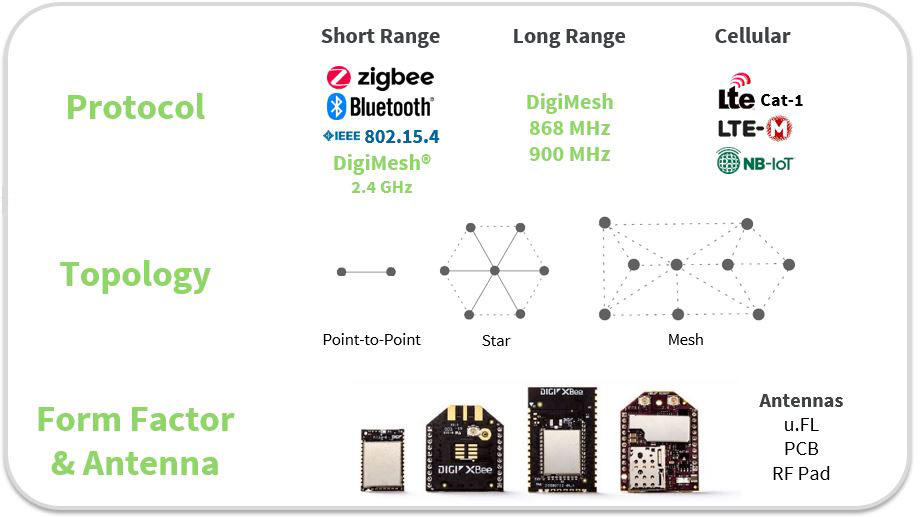
Digi XBee - 完整的IoT 网络解决方案
Digi 的使命是帮助开发人员简化和加速安全联网设备的开发、部署和管理。我们帮助客户节省时间和金钱,同时降低风险,使他们能够专注于自己的核心竞争力,而不是复杂的嵌入式无线设计。这一理念也体现在射频产品系列中。
XBee 射频模块是完整的IoT 网络解决方案的基础。除硬件外,Digi 还提供大量硬件和软件工具,以加速和简化产品和开发生命周期各阶段的任务。
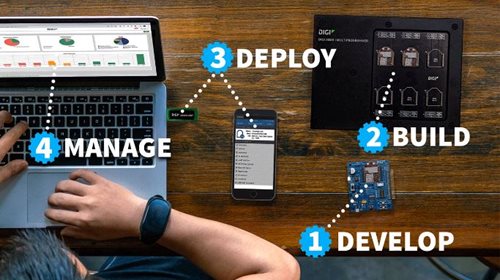
软件、工具和开发套件
Digi XBee 由一整套产品提供支持,使开发过程尽可能快速、简单。这套屡获殊荣的硬件、软件和程序库被称为Digi XBee Tools,为整个产品生命周期提供支持,包括
- 产品开发,包括硬件和软件设计
- 建造或制造最终产品
- 产品在现场的部署、调试和大规模推广
- 与现场设备的持续管理、维护和通信
我们的软件和硬件工具种类繁多,可供开发人员、制造团队、工程师甚至现场服务人员使用。其中许多工具都是 Digi 完全免费提供的。
下面是三个例子:
- Digi XCTU® 用于配置和测试。如果您刚开始使用Digi XBee 模块,请务必阅读我们广受欢迎的XCTU工具所含功能的实用概述。XCTU 具有配置、映射和范围测试设备的功能。在本博客中了解更多信息。
- Digi XBee PyCharm IDE 插件。如果您打算直接使用 MicroPython 编程语言将应用逻辑集成到 XBee 模块中,请查看Digi PyCharm IDE 插件,它允许您使用功能强大的开发套件直接在模块上部署和调试代码。
- XBee 移动 SDK。要利用额外的蓝牙通信选项,开发人员可使用Digi XBee Mobile SDKfor Bluetooth(蓝牙移动 SDK)创建移动应用程序,通过蓝牙与 XBee 通信,进行数据通信和管理。
Digi TrustFence的安全性
Digi 的首要安全产品是我们称之为TrustFence® 的框架。TrustFence 框架为 XBee 模块提供了多种全面实施的安全功能。例如,安全启动可确保只有经过授权和数字签名的固件才能在模块上运行。安全存储对本地文件系统进行加密,安全连接功能对数据通信进行验证和加密。
Digi TrustFence 的价值主张在于,它允许制造商安全地集成无线模块,而无需花费时间和金钱来实施安全套件。
远程连接:工业射频网关和Digi Remote Manager
对于不直接包含 IP 栈的产品,如 2.4 GHz 和 sub-GHz 模块,我们提供现货供应、 可编程网关 在需要时,可为远程连接提供射频和 IP 之间的桥梁。支持的 IP 接口有蜂窝、以太网和 Wi-Fi。不同型号的网关适用于不同的使用情况,包括严苛的工业应用。
XBee 蜂窝模块内含 IP 栈,可直接连接互联网。
客户可以使用或实施现有的或自定义的服务器、后端或云通信协议。我们提供了连接 AWS 或 Azure 等主要云提供商的示例和说明。
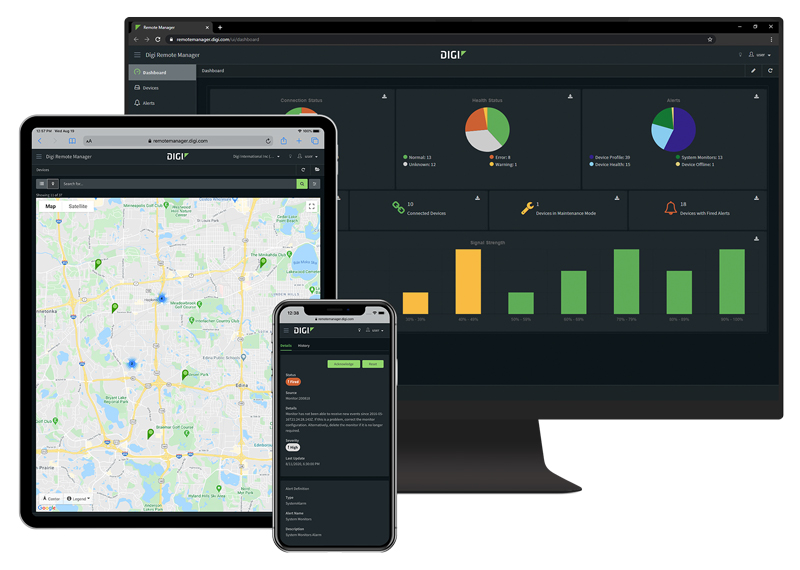 此外,客户还可以使用 Digi 基于云的设备管理和通信平台、 Digi 远程管理器.
此外,客户还可以使用 Digi 基于云的设备管理和通信平台、 Digi 远程管理器.
Digi Remote Manager 提供自动、安全的固件更新、配置设置、状态和设备健康监控、警报等管理功能。
通过Digi Remote Manager ,您可以完全访问 XBee 模块,不仅是蜂窝模块,还包括通过网关连接的模块。这样,您就可以使用平台提供的开放式应用程序接口,通过其他应用程序(如网络或云应用程序)访问终端节点的数据。
您还可以使用Digi Remote Manager 进行带外管理,它可通过命令行和串行连接提供安全访问。您可以在我们的 相关博文.
创建面向未来的解决方案
Digi XBee 模块之间的占地面积、引脚排列和软件兼容性使开发人员能够创建面向未来的解决方案。例如,开发人员可以轻松迁移到更新的模块,而无需更换载板或软件实现。这是使用 XBee 模块的主要优势之一。此外,我们的许多无线产品已在市场上销售了十年或更长的时间;产品寿命长是 Digi 的一个重要理念。
如果您选择集成度较低的模块或分立设计,则通常无法获得这些优势。
整合Digi XBee 模块的方法
.JPG?lang=en-US)
XBee 射频模块支持射频通信解决方案的三种主要用例:
- 将模块用作简单的通讯设备
- 将 XBee 模块连接到微型控制器或嵌入式设备上进行通信
- 直接在 XBee 模块上运行应用逻辑
为了支持第一种使用情况,例如创建一个简单的串行电缆更换解决方案,可以使用模块上运行的软件栈提供的配置参数对模块进行设置。
Digi 还提供库,允许开发人员将模块作为通信设备创建应用程序。这样,就可以轻松地将模块连接到微控制器,或将其嵌入到更复杂的设备中,如涵盖第二种使用情况的定制射频网关。
此外,Digi 还提供功能强大的 API 通信模式,允许开发人员利用协议和模块本身的所有功能。这包括确认和状态信息、诊断、网络发现、远程配置、远程固件更新、远程访问硬件接口(如模拟 I/O 或数字 I/O)等。
在第三种用例中,应用逻辑直接在 XBee 模块上运行。这可以使用 MicroPython 编程语言实现,使开发人员能够为其产品添加边缘智能。在这种情况下,不需要外部微控制器。有多个示例可用于标准或自定义协议,以及与直接连接到模块的传感器和执行器进行通信。
打造最终产品
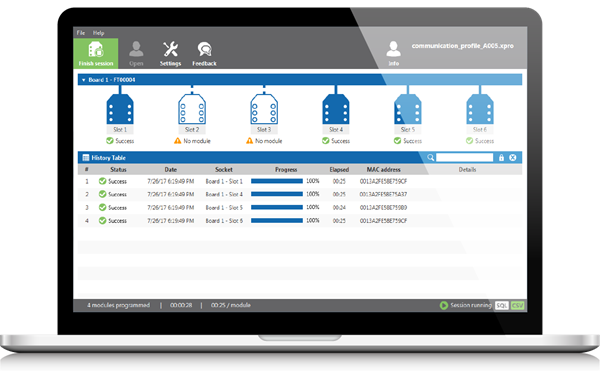 Digi XBee 多编程器。多编程器是一块硬件板,可同时对多达 6 个 XBee 模块进行编程,包括模块或蜂窝调制解调器固件更新以及配置设置和 MicroPython 代码的部署。甚至可以连接多个编程器,以增加同时编程的模块数量。
Digi XBee 多编程器。多编程器是一块硬件板,可同时对多达 6 个 XBee 模块进行编程,包括模块或蜂窝调制解调器固件更新以及配置设置和 MicroPython 代码的部署。甚至可以连接多个编程器,以增加同时编程的模块数量。
为了在现场部署产品,Digi 提供了一种名为 Digi XBee 网络助理.该助手旨在简化大规模推广过程,以便在短时间内轻松安装多个设备。XBee 网络助手不使用逻辑地图,而是使用物理地图(如平面图)来创建网络路线和链路质量的可视化。此外,Digi XBee 3 USB 适配器是一个包含在 USB 记忆棒中的 XBee 节点,可直接连接到个人电脑,无需使用开发板。我们发现,这种工具对现场安装和维护产品的工作人员特别有用。
预认证模块
无线认证可能会带来各种麻烦,耽误整个开发过程,影响产品上市时间。如果您要在不同地区推出产品系列,情况更是如此。
使用 Digi 模块可简化这一过程,因为我们的许多模块已在全球许多地区(包括美国和欧洲各国)获得预认证。使用预先认证的模块进行开发可大幅降低成本,并消除为通过认证要求而对产品进行额外迭代的风险。
应用和使用案例Digi XBee
Digi 无线模块的使用范围非常广泛,我们的模块如何集成到硬件中以实现远程操作的例子不胜枚举。
从遥控割草机等新奇有趣的应用,到起重机手控装置和农业饲料仓监控等工业应用,再到无线应急照明等基本应用,我们的客户无所不包。以下是我们最喜欢的几款产品:
除客户案例研究外,您还可以浏览我们的示例和指南以及项目图库中的示例。
Digi XBee 模块不仅功能强大,而且按照最高标准制造,即使在最苛刻的条件下也能确保多年的持续服务。